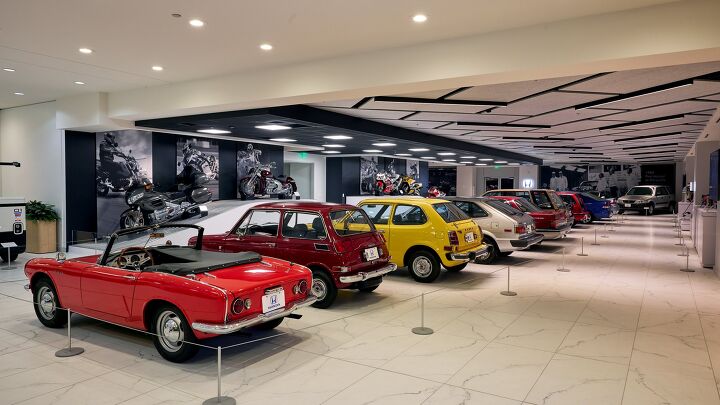Honda Fans Can Visit the Automaker's New Museum at Its California HQ

Believe it or not, Honda’s been around in the U.S. for decades, and to Celebrate, the automaker opened the American Honda Collection Hall to show some of its most iconic models. The display will be open during regular "Cars and Coffee" events starting in October.
Honda established its first American presence in 1959, also its first business presence outside of Japan. The automaker now sells hundreds of thousands of vehicles here each year, moving more than 980,000 last year. Its headquarters in Torrance, CA, is joined by a manufacturing facility in Ohio, and the company is gearing up to release new American-market EVs in the coming years.
The American Honda Collection Hall will house several historic models during the exhibition, including the 1070 Honda N600 Coupe, the first Honda sold in the United States, and a 1986 Acura Legend, the car that launched the brand in this country. Visitors will also see the 1997 CR-V, Honda’s first in-house SUV, and a 2006 Honda Insight, the country’s first mass-produced hybrid car.
Of course, Honda makes all manner of motorized vehicles, so the display will also include a variety of motorcycles, power equipment, and race cars. The 1962 Honda 50/Super Cub, 1969 Honda CB750A, and 1981 Honda CBX1000 will be displayed, along with a handful of other iconic bikes. Honda will show a marine outboard motor and generator on the power equipment side and three racing cars from the 199s, including the record-breaking 1997 Acura Integra Realtime.
[Images: Honda]
Become a TTAC insider. Get the latest news, features, TTAC takes, and everything else that gets to the truth about cars first by subscribing to our newsletter.

Chris grew up in, under, and around cars, but took the long way around to becoming an automotive writer. After a career in technology consulting and a trip through business school, Chris began writing about the automotive industry as a way to reconnect with his passion and get behind the wheel of a new car every week. He focuses on taking complex industry stories and making them digestible by any reader. Just don’t expect him to stay away from high-mileage Porsches.
More by Chris Teague
Latest Car Reviews
Read moreLatest Product Reviews
Read moreRecent Comments
- Wolfwagen I expect Renault to be less popular than Fiat
- ToolGuy Helium-3, baby!
- Roman Our 1999 Pontiac Sunfire Gt is still running without any issues. 25 years and counting.
- 28-Cars-Later I thought today's young people weren't even getting licenses to drive, so which is it?
- 28-Cars-Later Either last year or the year before I was discussing how The Dytopia™'s BEV schemes do not scale simply because the existing grid cannot generate enough power to replace ICE and the gigantic investment necessary in the grid was not forthcoming (Zelensky needed another house in Miami Beach after all you b!gots). So it struck me the only path to sort of do it is natural gas which became abundantly cheap 15 years ago because of fracking. Fast forward to more recently and surprise surprise we're attacking civilian use of natural gas out of nowhere for very little benefit. I couldn't find any good data to break down natural gas consumption between industrial use and civilian use, but spitballing I'd say the two largest chunks would be power generation and heating followed by small slices for other industrial use and home appliances- the latter probably being 5% or less (on my own gas bill its about 3-10% for the non furnace gas use depending on laundry loads). Some argued The Dystopia wanted to take away any energy freedom the proles have outside of electricity which they control on their whims, but I'm thinking that small number is optimal for them to take back because it doesn't force any additional infrastructure cost to gain (i.e. the low hanging fruit). As more power plants are spun up I expect a slow consolidation away from civilian nat gas because ManBearPig or whatever other fairy tale, but its really to power the gilded electronic cage they are constructing out of this once great nation. Seriously, break this down:Self lubricating Diesel engine with conventional OTS components, built for more than a ten year lifespan and 1m or more miles of use which can quickly be refueled at hundreds of locations (or fuel be brought to them). Pure BEV with some large amount of rare earths with a ten (?) year lifespan and perhaps 1m miles use but which has an avg daily downtime of 2 hours (?) to refuel and must be powered by a limited number of natural gas stations at static points (theoretically you could put a diesel fuel depot anywhere must faster and refill it with trucks). Other than ManBearPig fiction, your only savings in emissions is whatever the DEF isn't catching now (which is up to 90% in civilian diesel use per JLR) minus whatever emissions sins the nat gas burning creates. Think about how ridiculous all of this is to save 10-20% of emissions of only heavy trucks (BEV ships aren't ever going to be a thing) and you still have to frack like mad to have the natural gas to do it which would create the diesel in the first place. What is the nonsense?




































Comments
Join the conversation
Does Honda make anything cool enough to warrant being in a museum that doesn't sport an Acura badge?
1st generation Civic?
I'm actually kind of shocked California allows this museum to exist as a shrine to carbon emissions spewing, planet killing, death machines. :)